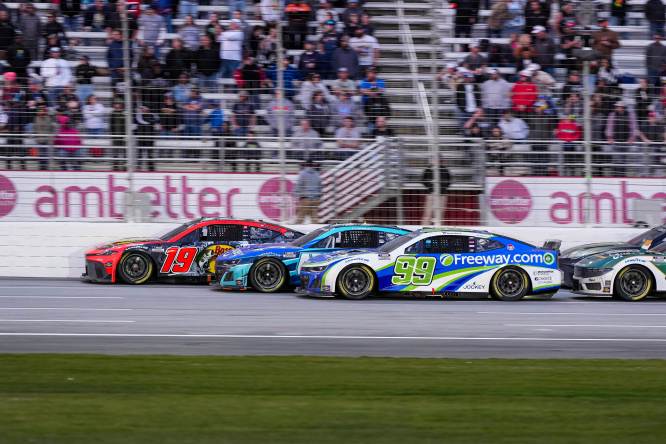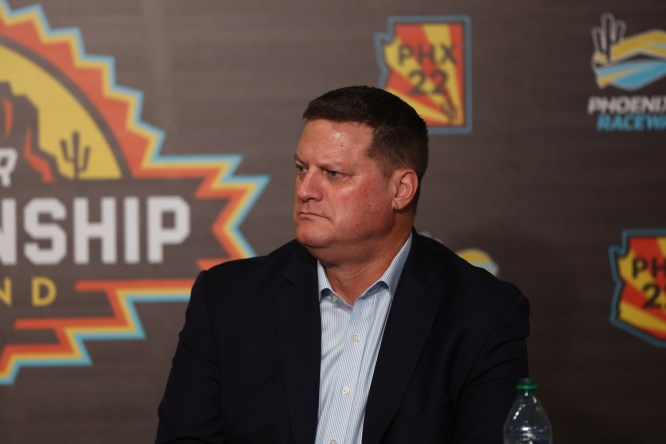
As part of the weekend long narrative surrounding the first NASCAR Cup Series race using the new short track rules package, Denny Hamlin expressed as he has done many times before, that a slight increase in horsepower would make a positive impact upon the racing product without affecting the financials of the sport.
The third-year, seventh-generation Cup Series car has been outfitted a speed reducing tapered spacer that chokes an engine capable of producing over 900 horses to a target range of 670. The car is also the heaviest Cup Series race car of all-time at 3,400 lbs. without the driver and has wider tires, larger brakes and was designed with a tremendous amount of drag.
From its conception, NASCAR designed the car with the intent that it would replicate Daytona and Talladega style pack races at intermediate tracks across the country but drivers rallied against it at the last minute two months prior to its debut event.

NASCAR wanted the car to make just 550 horsepower similar to the maligned NA18D rules package that was used at intermediate tracks from 2019-2021. In a way, drivers forcing NASCAR to increase the horsepower to 670 (backstory found here) actually made for a pretty compelling intermediate product that was a cross between NA18D style racing and a more traditional on-track product.
Drivers are still air blocking each other using the turbulence from their wake, but these tracks are wide and worn out enough to often given drivers a second option for passing, but that doesn’t exist on short tracks.
For one, these tracks are often flatter and features one groove, and the turbulence has been so severe in the NextGen car that a trailing driver can not even ride behind the driver in front of them without developing a severe aero push.
In other words, the car doesn’t want to turn as well without, non-disturbed clean air on the nose of the car, and it makes passing incredibly tedious. The revs are so low on this engine package that the result is more corner speed and the ability to downshift on corner exit to drive off without penalty.
That isn’t the case in say the Xfinity Series, where a faster trailing car can either attempt to out-brake the leading car or drive into the back of it to push it up the track, the tabled bump-and-run. Simply put, drivers cannot easily bump-and-run in the NextGen car.
NASCAR has made several attempts to modify the aerodynamic package, from lowering the rear spoiler to simplifying the rear diffuser, without much success beyond just making the car less stable by itself. It doesn’t change how inherently draggy a car designed to draft everywhere on tracks larger than 1.1 miles is.
NASCAR, Goodyear and drivers have collaborated on new tires but the general consensus is that the manufacturer hasn’t gone far enough because they have reservations about teams pushing their setups too far and forcing tire failures.
So, that is the conundrum, but there is one lever that NASCAR refuses to pull, and it’s horsepower. Speaking to the media on Saturday, Hamlin said horsepower wouldn’t make a significant improvement but it would be a commensurate compliment to every other adjustment.
“I think any horsepower I think you can add will make the racing better,” Hamlin said. “It is hard to pass because we are all in the gas so much. You have to get us out of the gas whether through the tire or the horsepower. That combination is what makes passing so difficult.
“The more you can get us out of the gas, which means if we have more horsepower, we have to let off sooner, that gives us the opportunity to overtake for the cars behind. 50 horsepower, while it may not be a game changer, any horsepower gain will be an advantage for passing.”
And despite claims to the contrary from NASCAR, Hamlin said it wouldn’t cost teams anything more.
“You just call up Doug Yates (at Ford) and TRD and say we are going to go back to our old 750 plate – it can be before next weekend, and they said it wouldn’t change any of our durability we have,” Hamlin said. “It can be done with one phone call with no additional money.”
Hamlin addressed the topic some more on his Monday podcast, Actions Detrimental, and was very adamant as a team owner of 23XI Racing and a two decade veteran driver that engines costs haven’t changed through all the changes.
“The engine bills are the same, I’ve been saying this forever,” Hamlin said on his podcast. “The engine bills are the same now as they were when they were 900. We buy engines, we know.”
So why does NASCAR refuse to increase horsepower, even back to those 2021 levels?
“I’ll tell you the same thing I told (NBC Sports reporter) Dustin Long, ‘call Jim France and ask,’ because I don’t know, I don’t have the answers for that,” Hamlin said.
When asked about it in November, NASCAR chief operating officer Steve O’Donnell said it was a matter of cost and meeting the interest of potential new manufacturers.

“You have to factor in what are the costs involved as well, right,” O’Donnel said. “It’s not as simple as just upping the horsepower. You better be ready for all your OEs to be onboard. It better make sense for any potential new OEM and technology. It’s not just a short-term answer.
“For us, we’re going to look at shifting specifically around that at our next test and see what we can do. There will be variations. Also some aero things we do with the underbody. There’s some things we found in Richmond from an aero standpoint that could work as well.”
NASCAR went to Phoenix to test a fix for the shifting and never even pursued it.
Ultimately, Hamlin has no idea why NASCAR will not respond to widespread pleas from his peers that they try even the slightest increase in horsepower as a data point.
“I don’t know I’ve seen … I don’t know,” Hamlin said. “You hear O’Donnell talk about it because reporters ask him constantly, ‘The drivers overwhelmingly want this, it seems like the fans want this, why not?’
“They [NASCAR] usually have a reason but sometimes it’s, ‘Hey we’re looking at all options, we’re not ruling it out, we’re not saying we are,’ right? This is the first thing, when it comes to horsepower, it’s the first thing I’ve not seen NASCAR react to the media about.
“Usually, they react to everything, when something is hot media-wise, they react to it. … There’s clearly a reason that’s not being explained to people or the drivers, of why we are where we are.”
Matt Weaver is a Motorsports Insider for Sportsnaut. Follow him on Twitter.

